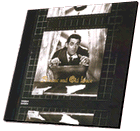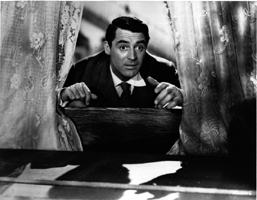

USA comedy
1944
bw 118 min.
Director: Frank Capra
CLV: out-of-print collectible
1 disc, catalog # CC1279L
 In 1941, director Frank Capra was at the peak of his profession with a
string of critical and popular successes behind him, including The
Bitter Tea of General Yen, Lady for a Day (which he would
remake thirty years later as Pocketful of Miracles, his
cinematic swan song), It Happened One Night (for which he won
an Oscar), Mr. Deeds Goes to Town, Lost Horizon, You
Can't Take It with You, Mr. Smith Goes to Washington, and
Meet John Doe.
In 1941, director Frank Capra was at the peak of his profession with a
string of critical and popular successes behind him, including The
Bitter Tea of General Yen, Lady for a Day (which he would
remake thirty years later as Pocketful of Miracles, his
cinematic swan song), It Happened One Night (for which he won
an Oscar), Mr. Deeds Goes to Town, Lost Horizon, You
Can't Take It with You, Mr. Smith Goes to Washington, and
Meet John Doe.
On the eve of the outbreak of World War II, Capra was looking for
one more sure-fire moneymaker. Capra had asked to head a military
field photo company. The Signal Corps offered him a major's
commission. He signed papers and was told to stand by. Capra needed
money to help keep his family going while he was away. Scouting for a
property, he looked east to Broadway (where he'd found the Pulitzer
Prize-winning You Can't Take It with You). He liked what he saw
in a raucous and macabre smash, Arsenic and Old Lace. An early
black comedy with an engaging mixture of gruesomeness and gags, the
play had opened at New York's Fulton Theatre on January 10, 1941,
garnered rave reviews and would eventually run for 1,444 performances.
The play concerns the daft doings of the Brewster clan, an odd
branch on the Addams Family tree. Drama critic Mortimer Brewster (Cary
Grant) must contend with the fact that his genteel, addle-pated maiden
aunts have been dispatching lonely old male visitors from their
Victorian parlor, with graciously proffered glasses of elderberry
wine, to the Great Beyond or, to put it less metaphysically, to a
grave in their basement. This they accomplished with the aid of their
nephew Teddy who, under the delusion that he is Teddy Roosevelt,
believes the stiffs to be yellow fever victims who perished while
working on the Panama Canal. More mayhem arises with the arrival of
the blackest sheep of the Mortimer fold, Jonathan, and his accomplice,
plastic surgeon Dr. Einstein (Peter Lorre).
Capra knew sure-fire material when he saw it. Essentially a one-set
play, it could be transferred to film quickly and
cheaply. Unfortunately, there was a hitch: Warner Brothers had already
snapped up the film rights and the movie version could not be released
until the play's theatrical run had ended -- a far-off prospect
considering the way advanced sales were going.
Undaunted, Capra pressed onward. He surrounded himself with a team
of pros: cameraman Sol Polito, editor Daniel Mandell and the
redoubtable team of twin screen writers, Julius and Philip Epstein,
who numbered among their credits such superb entertainments as
Casablanca, Mr. Skeffington, The Man Who Came to
Dinner and Now, Voyager.
The Epsteins basically left the pre-sold play intact, save for a
few changes. The day in question is moved from September to the more
apropos Halloween, and the action opened up to include a baseball game
and a trip to the marriage license bureau for Mortimer and his
fiancee, Elaine, before focusing in on the antics of chez
Brewster. Mortimer, in addition to being a drama critic, has become
the author of a couple of anti-matrimony tracts and his aforementioned
intended softened from aggressive to the cute ingenue played by
Priscilla Lane. Capra rounded out his cast with a crack cadre of
character actors: James Gleason, Jack Carson, Raymond Massey as Boris
Karloff, and Peter Lorre as, well, Peter Lorre.
Capra was soon shooting on a Warner's sound stage as speedily as
he had envisioned. And, as he wrote, he "couldn't be happier. I let
the scene-stealers run wild. It was a mugger's ball." (Perhaps he was
thinking back to his early days in silent comedy, helming Harry
Langdon comedies.)
The fun was to be short-lived. With one week left to shoot, Pearl
Harbor intervened and on December 8th, two Signal Corps officers came
to the set to swear Capra in. He was granted six weeks in which to
finish shooting, editing and previewing the film before reporting for
active duty on February 11th, 1942.
The movie stayed in the can until the 1944 completion of the
Broadway run (perhaps the longest deliberate withholding of a movie's
release), but Capra had an inkling of its ultimate reception while
overseas. He would occasionally hear G.I.s goof off yelling "Charge!"
A la Teddy, who would shriek it while racing up San Juan Hill --
actually the Brewster house stairs -- in the movie. While in the
R.A.F. mess hall at Pinewood Studios, pilots would run toward Capra's
table brandishing imaginary swords, again yelling "Charge!" Capra
realized they'd seen the film and loved it. (Jack Warner had released
it early to the armed services.) "Charge" became a catchword wherever
there were Americans in uniform and after the war Dodger fans took it
up as a call to action.
When the film was released in 1944, it was a resounding success. In
fact, it's been said, nobody has ever lost money on Arsenic and Old
Lace, whether in stock, high school or revival. Nobody
. . . except for Frank Capra. He discovered when the film opened that
he had outfoxed himself. As he writes in his autobiography The Name
Above the Title: "You will probably remember the big plot to make
Arsenic and Old Lace on a percentage basis so I wouldn't have
to dig into the old sock to keep my family going while I was in
uniform. How did the plot work out? A disaster. The picture was not
played in theaters until 1944. Then it made money so fast my first
percentage check was for $232,000! Great! Oh, sure. The federal and
state income taxes on it added up to $205,000!"
-- JONATHAN BENAIR
Credits
Producer: Frank Capra
Director: Frank Capra
Screenplay: Julius J. & Philip G. Epstein
From the stage play by: Joseph Kesselring, as produced by Howard Lindsay and
Russel Crouse
Director of Photography: Sol Polito, A.S.C.
Editor: Daniel Mandell
Art Director: Max Parker
Sound: C.A. Riggs
Gowns: Orry-Kelly
Music: Max Steiner
Musical Director: Leo Forbstein
Makeup: Perc Westmore
Special Effects: Bryon Haskin, A.S.C., Robert Burks, A.S.C.
Dialogue Director: Harold Winston
Transfer
This edition of Arsenic and Old Lace was transferred from a
35mm fine grain print made from the original negative.




